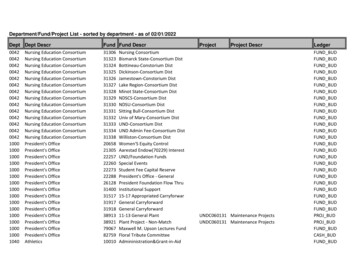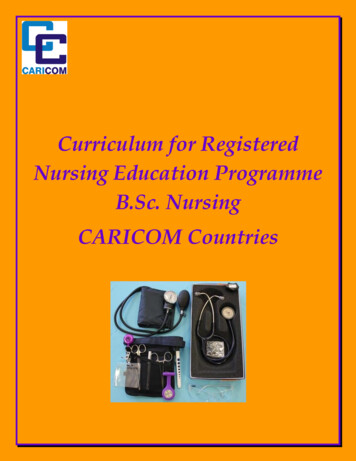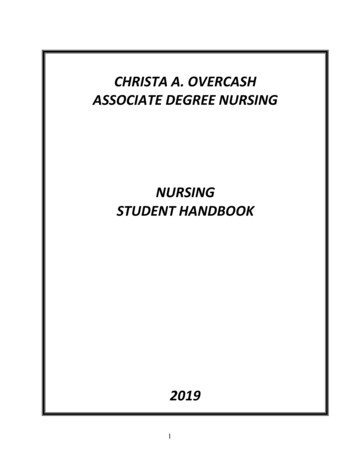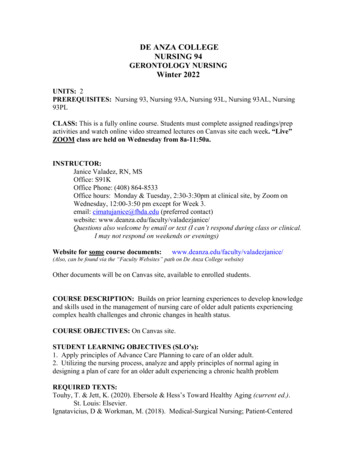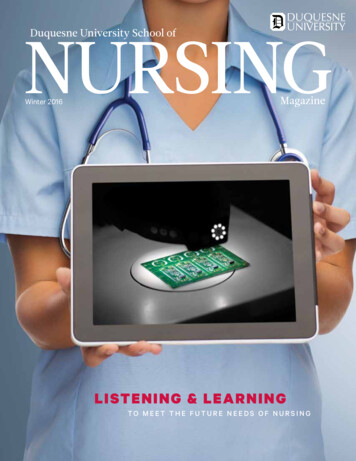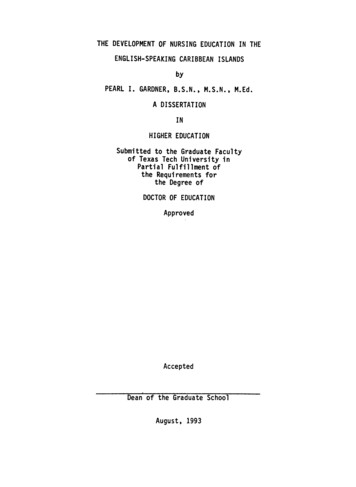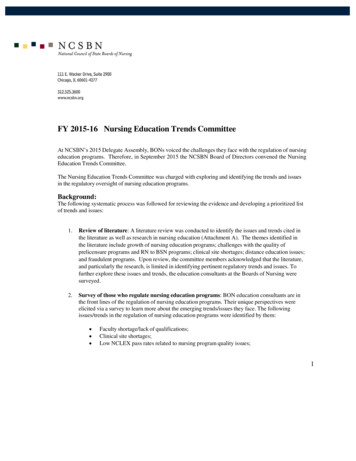
Transcription
FY 2015-16 Nursing Education Trends CommitteeAt NCSBN’s 2015 Delegate Assembly, BONs voiced the challenges they face with the regulation of nursingeducation programs. Therefore, in September 2015 the NCSBN Board of Directors convened the NursingEducation Trends Committee.The Nursing Education Trends Committee was charged with exploring and identifying the trends and issuesin the regulatory oversight of nursing education programs.Background:The following systematic process was followed for reviewing the evidence and developing a prioritized listof trends and issues:1.Review of literature: A literature review was conducted to identify the issues and trends cited inthe literature as well as research in nursing education (Attachment A). The themes identified inthe literature include growth of nursing education programs; challenges with the quality ofprelicensure programs and RN to BSN programs; clinical site shortages; distance education issues;and fraudulent programs. Upon review, the committee members acknowledged that the literature,and particularly the research, is limited in identifying pertinent regulatory trends and issues. Tofurther explore these issues and trends, the education consultants at the Boards of Nursing weresurveyed.2.Survey of those who regulate nursing education programs: BON education consultants are inthe front lines of the regulation of nursing education programs. Their unique perspectives wereelicited via a survey to learn more about the emerging trends/issues they face. The followingissues/trends in the regulation of nursing education programs were identified by them: Faculty shortage/lack of qualifications;Clinical site shortages;Low NCLEX pass rates related to nursing program quality issues;1
3.Difficulties with proprietary nursing programs, such as questionable program quality andlow NCLEX pass rates;Distance education program concerns; for example, programs not complying with out-ofstate approval requirements;Issues with accreditors, such as programs meeting accreditation standards, but not BONapproval requirements;Challenges with programs increasing simulation percentages, but not securing the neededresources, such as faculty development.Expert opinion: The Nursing Education Committee members collected and collated the issuesand trends from the literature and education consultant survey. They then discussed their ownexperiences and knowledge as subject matter experts and identified additional issues/trends relatedto nursing education.All the issues/trends from these sources (literature, education consultants and the committee) wereaggregated to develop an evidenced-based survey of trends and issues in the regulatory oversightof nursing programs. This survey was then disseminated to the EOs of the BONs since they seethe broader picture of their BONs’ needs.4.Survey of BON executive officers (EOs): The EOs were asked to identify and rank order the topfive trends/issues on the survey. The responses were weighted based on averages. Below are theresults of this survey presented in a prioritized list of trends/issues in the oversight of nursingeducation programs:FindingsFollowing a systematic process, the following are trends and issues identified in the regulatory oversight ofnursing education programs:#1 – Faculty shortage/lack of qualified faculty#2 – Clinical site shortages#3 – Concerns about quality of prelicensure education programs, signaled by lowNCLEX pass rates, student attrition, etc.#4 – Lack of robust outcome measures for nursing education programs (besides first-timeNCLEX pass rates)#5 – Rapidly changing expectations for nursing practice and education (e.g., evolvingscopes of practice for LPNs/VNs and RNs and obtaining the education to meetthese changes.2
1Attachment A.Selected Literature Review: Emerging Regulatory Trends in Nursing EducationIntroductionA review of the literature was conducted in CINAHL, MEDLINE and the Journal of Nursing Regulationto search for current articles published on the trends in the regulatory oversight of nursing education from2010 to June 2016. Additionally, seminal work on nursing education from 2010 to June 2016 that is notin the databases (such as books, white papers, etc.) has been included. This search yielded the followingthemes: growth in the number of graduates and nursing education programs, quality of existing nursingeducation programs, limited numbers of clinical sites, increase in distance education programs, increase inuse of simulation and concerns with fraudulent credentials and fraudulent programs. See Appendix I foran evidence table summarizing the literature that was identified.Growth in Nursing Graduates and Nursing Education ProgramsThe Institute of Medicine’s report (2011) recommended that 80% of registered nurses (RNs) be educatedat the baccalaureate level by the year 2020, which in turn helped to stimulate the number of BSN nursingeducation program enrollments, nursing graduates, and nursing education programs (Hewitt, 2016).Buerhaus, Auerbach, & Staiger (2014) reviewed data from the Integrated Postsecondary Education DataSystem (IPEDs), which is a longitudinal database of trends in postsecondary education consisting ofannual surveys conducted by the National Center for Education Statistics. The researchers reported arapid increase in the number of graduates from 2002-2012. At the beginning of this 10-year period, thenumber of BSN graduates was 34,808. By the end of this period, the number of BSN graduates grew to97,629, which reflects an absolute growth of 180% or 62,821 BSN graduate nurses. Additionally, therehas been a growth in RN programs. The National Council of State Boards of Nursing (2015a) reported a46% (from 1,610 in 2004 to 2,347 in 2014) increase in approved RN programs.Similarly, RN to BSN program enrollments have increased increased, and again this may result from theInstitute of Medicine’s (2011) recommendation to increase the proportion of BSN nurses in the
2workforce. The American Association of Colleges of Nursing reports that enrollment in RN to BSNprograms has increased every year for the last 9 years, with a 288% increase from 2003 (31,215 RN toBSN programs) to 2011 (89,975 RN to BSN programs) (American Colleges of Nursing, 2012).The growth of RN programs leads to the simple question of whether the supply of adequately preparedfaculty are able to meet these growing demands (Buerhaus et al., 2014; National Council of State Boardsof Nursing, 2015a). The 2015-2016 AACN Special Survey on Vacant Faculty Positions (Li, Stauffer &Fang, 2015), which shows the nursing faculty vacancy trends in baccalaureate or higher nursingeducation, reported that 17.5% (N 130) of responding schools had a need for additional faculty but didnot have any full-time vacancies in order to hire. Additionally, for the schools that reported full-timevacancies and could hire faculty, the vacancy rate was 7.1% (Li, Stauffer & Fang, 2015), which meansthat some nursing education programs are operating without full faculty capacity.Quality of RN to BSN and Prelicensure Nursing Education ProgramsIn addition to the shortage of faculty, another concern related to the growth of nursing education programsis the quality of the programs (Buerhaus et al., 2014; Hooper, McEwen, & Mancini, 2013). Hooper et al.(2013) report variability in prerequisite requirements of RN-to-BSN programs, highlighting that someprograms have flexible requirements; yet, others eliminate the need for prerequisites (content in the sciencesand humanities) entirely. Also, the researchers state that variability exists across programs in the timeperiod required between completing the prerequisite and initiating the nursing education program.Researchers have called for the use of standardized competencies in efforts to promote consistency acrossRN-BSN programs (Hooper et al., 2013; McEwen, 2015).While there are concerns about the consistency of some RN to BSN programs, those that are accredited bythe national nursing accreditation agencies [Commission on Collegiate Nursing Education (CCNE) orAccreditation Commission for Education in Nursing (ACEN)] must meet certain standards. For example,programs accredited by CCNE must meet 109 outcomes of the AACN Essentials of ce,whichcanbecategorizedasprofessional
3identity/communication (25%), nursing across the lifespan (25%), leadership (25%), population health(13%) and evidence-based practice/quality improvement (12%) (Kumm & Fletcher, 2012; Martin, Godfrey& Walker, 2015). Additionally, acknowledging that the dramatic increase of RN to BSN programs couldchallenge the quality of these programs, AACN (2012) published a white paper calling for quality clinicalpractice experiences to transition the student’s competencies to the baccalaureate level, such as enhancingtheir understanding of organizations/systems, leadership, evidence-based practice and community andpopulation-based care. It is not known, however, how many RN to BSN programs are not nationally nursingaccredited, and only 13 boards of nursing have regulatory authority over RN to BSN programs. Therefore,it is plausible that some RN to BSN programs have no nursing oversight, which could adversely affect thequality of these programs and nursing practice.There are challenges in prelicensure education as well. In their regulatory oversight of prelicensure nursingeducation programs, BONs have reported quality issues with nursing education programs. While thesechallenges are not widespread, in some programs (particularly for-profit programs) BONs are seeingdecreased first-time NCLEX pass rates, as well as programs struggling to meet approval standards (NationalCouncil of State Boards of Nursing, 2016).Similarly, the literature reports challenges in prelicensure nursing education. In the seminal Carnegie Studyof Nursing Education (Benner, Sutphen, Leonard & Day, 2010), researchers found weaknesses in the highlyabstract way nurse educators teach in the classroom, where students are expected to memorize taxonomies,such as the signs, symptoms, interventions and outcomes of conditions, rather than integrating actual patientsituations. Likewise, the study found that the prerequisite social science and technology courses lack rigor.They found the strengths of prelicensure nursing education to be: (a) developing ethical comportment instudents; and (b) providing powerful clinical experiences where students can integrate both classroom andclinical teaching.
4Nursing programs, however, are beginning to step up to the challenges. In a follow-up guest editorial,Benner (2012) reported encouraging news on how programs are making changes, based on the CarnegieStudy’s recommendations. Likewise, Djukic et al. (2013) revealed good news about modest improvementsbeing made in the preparedness of new graduates in the areas of quality and safety, perhaps related to theQuality and Safety Education for Nurses (QSEN) initiative that has been integrated throughout prelicensureprograms. While these reports are encouraging to regulators, there is still room for improvement.Limited Numbers of Clinical SitesAnother issue affecting the quality of nursing education programs is the lack of appropriate clinical sites(McNelis, Fonacier, McDonald, & Ironside, 2011; McNelis, et al., 2014; National Council of StateBoards of Nursing, 2015a). The National League for Nursing commissioned a survey (N 2,386) toexplore clinical education in prelicensure programs (Ironside & McNelis, 2010; McNelis et al., 2011).The survey was completed by faculty from associate, diploma, and baccalaureate programs across 50states and it was found that lack of quality clinical sites was ranked as the most important barrier toclinical learning followed by lack of qualified faculty. Additionally, the results of the survey showed thatconventional strategies (e.g., providing clinical rotations on evenings, nights, weekends, and/or holidays)to manage barriers and challenges were not very effective. Recommendations from this study includedfurther research of more effective approaches to improving the current status of clinical education.Use of SimulationNursing education programs have been increasingly integrating simulation into their curricula in order tooptimize clinical experiences primarily due to continued decreases in access to traditional clinicalexperiences (Jeffries, Dreifuerst, Kardong-Edgren, & Hayden, 2015). Until recently, the question of howmuch clinical experience can be substituted with the use of simulation has concerned nurse educators andregulators. In 2014, the National Council of State Boards of Nursing (NCSBN) published results of amultisite study evaluating the use of simulation as a substitute for traditional clinical hours (Hayden,Smiley, Alexander, Kardon-Edgren, & Jeffries, 2014). The findings revealed that up to 50 percentsimulation can be substituted for traditional clinical experience in nursing education programs.
5Subsequently, NCSBN convened an expert panel consisting of representatives from the InternationalNursing Association for Clinical Simulation and Learning, American Association for Colleges ofNursing, National League for Nursing, Society for Simulation in Healthcare, BONs, and NCSBN todevelop national guidelines to assist undergraduate nursing education programs in the use of simulation.These guidelines recommend a strong commitment from the faculty/school, adequate facilities toaccommodate simulation, appropriate educational and technological resources and equipment, qualifiedand trained faculty and simulation lab personnel, and established policies and procedures for simulation(Alexander et al., 2015).Before the results of NCSBN’s multi-site simulation study were disseminated, Hayden, Smiley & Gross(2014) surveyed the boards of nursing as to their requirements related to the use of simulation inprelicensure nursing programs to replace clinical experiences. These results would serve as a benchmarkfor future regulatory comparisons. At that time, 8 states did not allow simulation to replace clinicalexperiences, and 4 states required a specific percentage of simulation that could replace clinicalexperiences (generally 25%). For the remaining 38 states, either the regulations were silent or the BONsmade decisions on a case-by-case situation. Since the release of the NCSBN national simulation studyresults, states have begun to develop policies or rules addresssing the use of simulation, though there havebeen no further surveys to document the changes being made.A recent national survey (Breymier et al., 2015) found that there was considerable variability in, andconfusion around, the ratio of simulation hours to clinical experience hours used. These ratios aredetermined by the nursing program. Some programs use a 1:1 ratio, others use 1:2, and still others use2:1. For example, in the NCSBN National Simulation study (Hayden et al., 2014), the ratio used was 1:1.Currently there is no evidence clarifying which ratio is most effective. Additionally, the researchersfound that faculty-to-student ratios, in the same schools, were greater in the clinical instruction settingthan in simulation. The researchers asked many important questions, but this one is particularly pertinentfor nurse regulators: How can faculty in clinical settings monitor students effectively when they have
6double the students that simulation faculty have, particularly when students must be stopped or correctedbefore a mistake is made? As the use of simulation in nursing education increases, we will need moreevidence to answer some of these questions.Distance Education ProgramsDistance education in nursing has the advantage of providing increased access and flexibility to nursingstudents (Lowery & Spector, 2014; Murray, 2013). In addition, distance education increases facultycapacity (Murray, 2013). The literature on distance education emphasizes its use as an innovativeeducational strategy (Du, et al., 2013; Murray, 2013); although, there is a dearth of published literature onregulatory oversight of distance education nursing programs (Lowery & Spector, 2014).Similar to the variability of BON approval processes for nursing education programs, variability is alsoevident in the nursing regulation of distance education programs and in licensure requirements of faculty(Lowery & Spector, 2014). The National Council of State Boards of Nursing conducted a survey of itsmember boards and identified that 48% of BONs required didactic faculty to be licensed where theprogram was located, 17% required didactic faculty to be licensed in states where the program andstudents are located, and the remaining BONs responded with “other” (e.g., “we don’t have distanceeducation programs” (Lowery & Spector, 2014). Additionally, the survey found that BONs typicallyrequire clinical faculty to be licensed in the state where they are supervising students in clinical, with 29%of BONs requiring clinical faculty to be licensed in both the home and host state.This variability across distance education programs in nursing motivated action to address these matters.In 2014, the NCSBN Distance Learning Education Committee developed Regulatory Guidelines forPrelicensure Programs. These guidelines were developed to promote consistency for the regulation ofprelicensure distance education nursing programs (Lowery & Spector, 2014).Fraudulent Credentials and Fraudulent Nursing Education ProgramsMany boards of nursing (BONs) have been experiencing increased fraudulent activity related tocredentials verification for licensure and nursing education programs (Spector & Woods, 2013; Tse,
72015). The issue of fraudulent credentials, though not new, has increased likely due to the advances andreliance on technology and the Internet (Tse, 2015). This has allowed for the proliferation of fabricatededucation-related documents such as diplomas, degrees, transcripts, etc. In order to assist in preventingfraud, BONs should try to identify patterns of increased numbers of applicants from certain countries orregions; recognize irregularities across documents from a certain country or region; check with otherBONs to determine similar experiences; and share discovery of fraudulent information with other BONs(National Council of State Boards of Nursing, 2015b).Boards of nursing have also been challenged with fraudulent nursing education programs. These nursingprograms claim to have obtained BON approval when in fact they are not approved by the BON (Spector& Woods, 2013). Many of these programs build a rapport with students and gain their trust so theyseemingly have the students’ best interest in mind (Ayars & Thomas, 2015). Early identification isnecessary in stopping the spread of fraudulent nursing education programs and fraudulent practices. Thiscan be accomplished by the BONs educating the public about these fraudulent programs and sharinginformation about these programs with other BONs so that the programs is unable to easily relocate toanother jurisdiction.Additionally, there have been concerns about fraudulent practices arising from for-profit nursingeducation programs (Morgan, 2012). The primary concern about for-profit nursing education programs isthe lack of transparency about the quality of these types of programs. For-profit programs tend to offerbaccalaureate programs to those students who already have completed education as a licensed practicalnurse (LPN) or an associate-degree registered nurse. Morgan (2012) suggests that stricter regulatoryoversight of LPN-BSN and RN-BSN programs is necessary for these for-profit nursing educationprograms.
8SummaryThe published literature reveals significant trends and issues in nursing education. These include: thegrowth in the number of graduates and nursing education programs and the ability to meet these increaseddemands; the concerns about the quality of prelicensure and RN to BSN nursing education programs; theclinical site shortages; variability in the regulation and quality of distance education nursing programs; thevariation in the percentages of simulation within nursing curricula; and concerns with fraudulentcredentials and fraudulent programs.ReferencesAlexander, M., Durham, C. F., Hooper, J. I., Jeffries, P. R., Goldman, N., Kardong-Edgren, S., Kesten, K.S., Spector, N. Tagliareni, E., Radtke, B. & Tillman, C. (2015). NCSBN simulation guidelines forprelicensure nursing programs. Journal of Nursing Regulation, 6(3), 39-42.American Association of Colleges of Nursing. (2012). White paper: Expectations for practice experiencesin the RN to baccalaureate curriculum. Retrieved from pers/RN-BSN-White-Paper.pdfAyars, V., & Thomas, M. B. (2015). Collaborating to eliminate fraudulent nursing education programs.Journal of Nursing Regulation, 5(4), 57-60.Benner, P. (2012). Educating nurses: A call for radical transformation – How far have we come? Journalof Nursing Education, 51(4), 183-184.Benner, P., Sutphen, M., Leonard, V. & Day, L. (2010). Educating nurses: A call for radicaltransformation. Josey-Bass: San Francisco, CA.Breymier, T. L., Rutherford-Hemming, T., Horsley, T. L., Atz, T., Smith, L. G., Badowski, D. & Connor,K. (2015). Substitution of clinical experiences with simulation in prelicensure nursing programs:A national survey in the United States. Clinical Simulation in Nursing. 11(11), 472-478.
9Buerhaus, P. I., Auerbach, D. I., & Staiger, D. O. (2014). The rapid growth of graduates from associate,baccalaureate, and graduate programs in nursing. Nursing Economics, 32(6), 290-295, 311-312.Du, S., Liu, Z., Liu, S., Yin, H., Xu, G., Zhang, H., & Wang, A. (2013). Web-based distance learning fornurse education: A systematic review. International Nursing Review, 60(2), 167-177.Djukic, M., Kovner, C.T., Brewer, C.S., Fatehi, F., Bernstein, I. & Aidarus, N. (2013). Improvements ineducational preparedness for quality and safety. (2013). Journal of Nursing Regulation, 4(2), 1521.Hayden, J. K., Smiley, R. A., & Gross, L. (2014). Simulation in nursing education: Current regulationsand practices. Journal of Nursing Regulation, 5(2), 25-30.Hayden, J. K., Smiley, R. A., Alexander, M., Kardon-Edgren, S., & Jeffries, P. R. (2014). The NCSBNNational Simulation Study: A longitudinal, randomized controlled study replacing clinical hourswith simulation in prelicensure nursing education. Journal of Nursing Regulation, 5(2), S1-S64.Hewitt, P. (2016). The call for 80% BSNs by 2020: Where are we now? Nurse Educator, 41(1), 29-32.Hooper, J. I., McEwen, M., & Mancini, M. E. (2013). A regulatory challenge: Creating a metric forquality RN-toBSN programs. Journal of Nursing Regulation, 4(2), 34-38.Institute of Medicine. (2011). The future of nursing: Leading change, advancing health. Washington, DC:The National Academies Press.Ironside, P. M., & McNelis, A. M. (2010). Clinical education in prelicensure nursing programs: Findingsfrom a national survey. Nursing Education Perspectives, 31(4), 264-265.Jeffries, P. R., Dreifuerst, K. T., Kardong-Edgren, S., & Hayden, J. (2015). Faculty development wheninitiating simulation programs: Lessons learned from the National Simulation Study. Journal ofNursing Regulation, 5(4), 17-23.
10Kumm, S. & Fletcher, K. (2012). From daunting tasks to new beginnings: bachelor of science in nursingcurriculum revision using the new Essentials. Journal of Professional Nursing, 28(2), 82-89.Li, Y., Stauffer, D.C., & Fang, D. (2015). Special survey on vacant faculty positions for academic year2015-2016. Retrieved from rchdata/vacancy15.pdfLowery, B., & Spector, N. (2014). Regulatory implications and recommendations for distance educationin prelicensure nursing programs. Journal of Nursing Regulation, 5(3), 24-31.Martin, D., Godfrey, N. & Walker, M. The baccalaureate big 5: What Magnet hospitals should expectfrom a baccalaureate generalist nurse. JONA, 45(3), 121-123.McEwen, M. (2015). Promoting differentiated competencies among RN-to-Bachelor of Science inNursing program graduates. Journal of Nursing Education, 54(11), 615-623.McNelis, A. M., Fonacier, T., McDonald, J., & Ironside, P. M. (2011). Optimizing prelicensure students'learning in clinical settings. Nursing Education Perspectives, 32(1), 64-65.McNelis, A. M., Ironside, P. M., Ebright, P. R., Dreifuerst, K. T., Zvonar, S. E., & Conner, S. C. (2014).Lerning nursing practice: A multisite, multimethod investigation of clinical education. Journal ofNursing Regulation, 4(4), 30-35.Morgan, J. M. (2012). Regulating for-profit nursing education programs. Journal of Nursing Regulation,3(2), 24-30.Murray, T. A. (2013). Innovations in nursing education: The state of the art. Journal of NursingRegulation, 3(4), 25-31.National Council of State Boards of Nursing. (2015a). The 2015 environmental scan. Journal of NursingRegulation, 5(4 Supplement), S3-S36.
11National Council of State Boards of Nursing. (2015b). Resource manual on the licensure ofinternationally-educated nurses. Retrieved from https://www.ncsbn.org/15 FEN manual.pdf.National Council of State Boards of Nursing. (2016). A changing environment: 2016 NCSBNenvironmental scan. Journal of Nursing Regulation, 6(4), 4-37.Spector, N., & Woods, S. L. (2013). A collaborative model for approval of prelicensure nursingprograms. Journal of Nursing Regulation, 3(4), 47-52.Tse, E. (2015). Identifying fraudulent credentials from internationally educated nurses. Journal ofNursing Regulation, 6(1), 57-61.
12Appendix I - Nursing Education Trends - Evidence TableCitationAlexander et al. (2015)Type ofPublicationGuidelines –Peer-reviewedjournalAACN (2012)White PaperProvides recommendations forpractice experiences in RN toBSN programs.Ayars & Thomas (2015)Peer-reviewedjournalDescribes the challenges ofidentifying fraudulent programsfor BONs.Benner (2012)Guest editorial –Peer-reviewedjournalResearch - BookProvides update on the CarnegieStudy of Nursing Educationrecommendations.Determines signaturepedagogies of nursingeducation.Breymier et al. (2015)Research – PeerreviewedjournalProvides data from a survey ofprelicensure schools of nursingto identify substitution ratios forsimulation hours to supervisedclinical hours.Buerhaus, Auerbach, & Staiger(2014)Research - PeerreviewedjournalReviews data from IntegratedPostsecondary Education DataSystem (IPEDS) from 1984-2012.Benner, Sutphen, Leonard, &Day (2010)PurposeFindings/Main PointsProvides guidelines onsimulation for BONs and nursingeducation programs.BONs can utilize the guidelines toevaluate the use of simulation as asubstitute for clinical experiences innursing programs. Additionally, nursingprograms can use the guidelines toimplement simulation programs.RN to BSN programs should includepractice experiences that reflectbaccalaureate-level decision makingand critical thinking.Illustrates the importance of thecollaboration that is necessary whenidentifying and processing fraudulentprograms.Three years later, programs are makingchanges based on the Carnegie Studyof Nursing Education.This seminal study found the strengthsof nursing education to be in clinicalinstruction and ethics; and theweaknesses to be lack of rigor in theprerequisites and classroom teaching. Schools of nursing reported varioussubstitution ratios of simulation hoursto clinical experience hours; someusing a 1:1, 1:2, or 2:1 ratio No current evidence clarifying the mosteffective ratio Faculty-to-student ratios were greaterin the clinical instruction setting than insimulationRapid increase in numbers of graduatesfrom 2002-2012 as well as increase inthe number of nursing educationprograms.Committee ImplicationsIncreased percentage of simulationreplacing clinical is a challenge forBONs right now.Given the dramatic increase in thenumber of RN to BSN programs, theneed to maintain academic rigor isessential to regulators.BONs need guidance for identifyingincreasing numbers of fraudulentprograms.Educators should continually reviewand revise curricula based on theevidence.BONs should be aware of thesestrengths and weaknesses whenrevising their rules and regulations.Increased use of simulation presentschallenges to the BONs.Concern over the quality of nursingeducation and whether nurses arebeing prepared adequately.
13CitationDjukic et al. (2013)Type ofPublicationResearch – PeerreviewedjournalPurposeExamines the differences inreported quality and safetypreparedness between twocohorts of entry-level licensedregistered nurses.Evaluates the efficacy of webbased distance education fornursing students and practicingnurses.Du et al. (2013)Research – PeerreviewedjournalHayden, Smiley, Alexander,Kardong-Edgren, & Jeffries(2014)Research – PeerreviewedjournalEvaluates the use of simulationas a substitute for traditionalclinical hours.Hayden, Smiley, & Gross (2014)Research – PeerreviewedjournalHewitt (2016)Peer-reviewedjournalProvides data from a survey ofBONs identifying theirrequirements related to the useof simulation in prelicensurenursing programs to replaceclinical experiences.Provides update of the currentstate of the IOM that 80% ofregistered nurses be preparedat the baccalaureate level by2020.Hooper, McEwen, & Mancini(2013)Peer-reviewedjournalDescribes and recommends anational metric of qualityindicators for RN to BSNprograms.Institute of Medicine (2011)Report,disseminated ina bookProvides recommendations topositively transform the futureof nursing.Findings/Main PointsCommittee ImplicationsOver three years, there have beenmodest improvements in preparednessof new graduates in the areas of qualityand safety.While there have been modestimprovements in quality and safetyeducation, there is room for growth.Web-based distance education hasproduced equivalent or betteroutcomes in knowledge acquisitionbased on the review of 9 randomized,controlled trials.Up to
that some nursing education programs are operating without full faculty capacity. Quality of RN to BSN and Prelicensure Nursing Education Programs . In addition to the shortage of faculty, another concern related to the growth of nursing education programs is the quality of the programs (Buerhaus et al., 2014; Hooper, McEwen, & Mancini, 2013).




